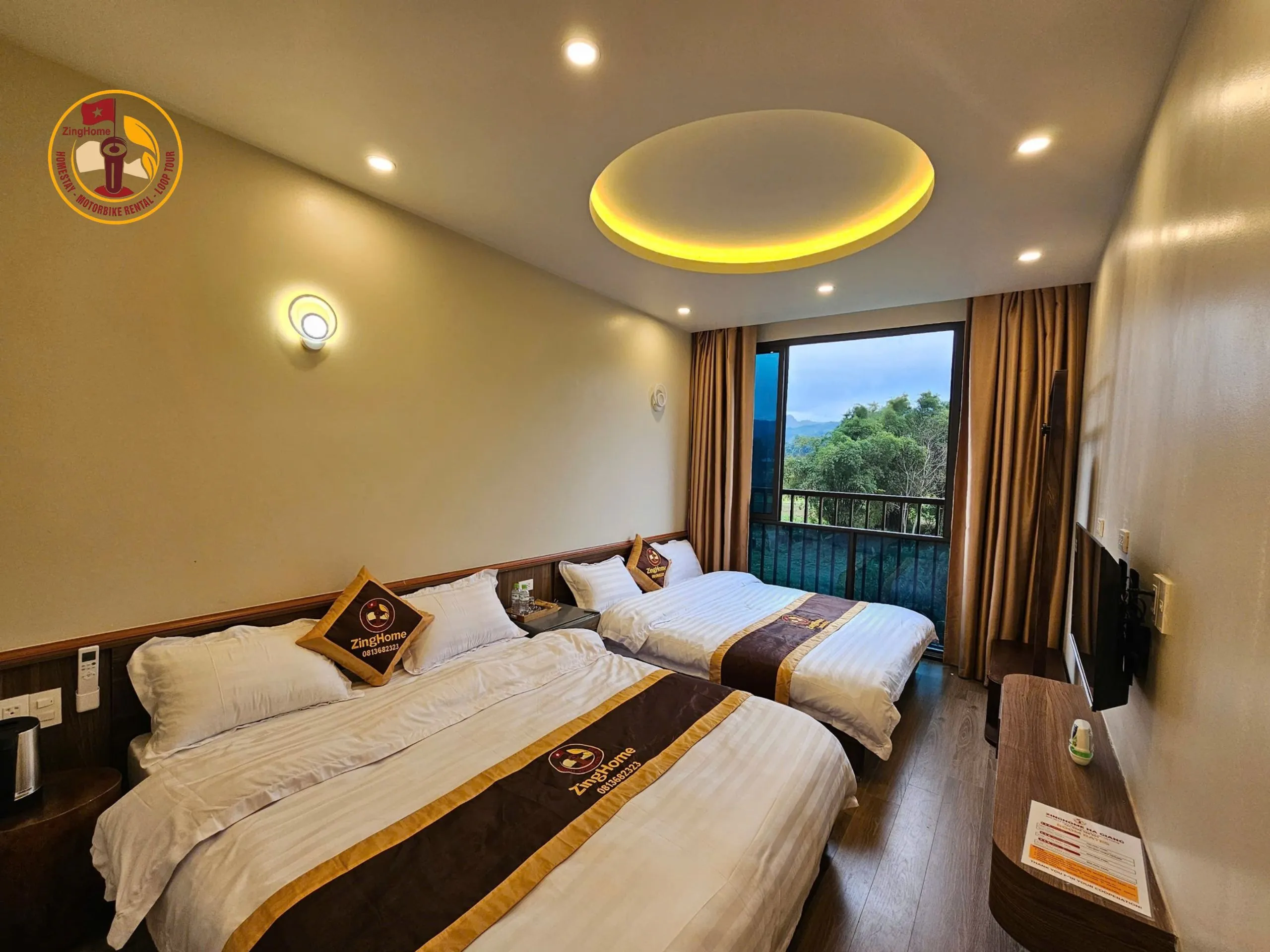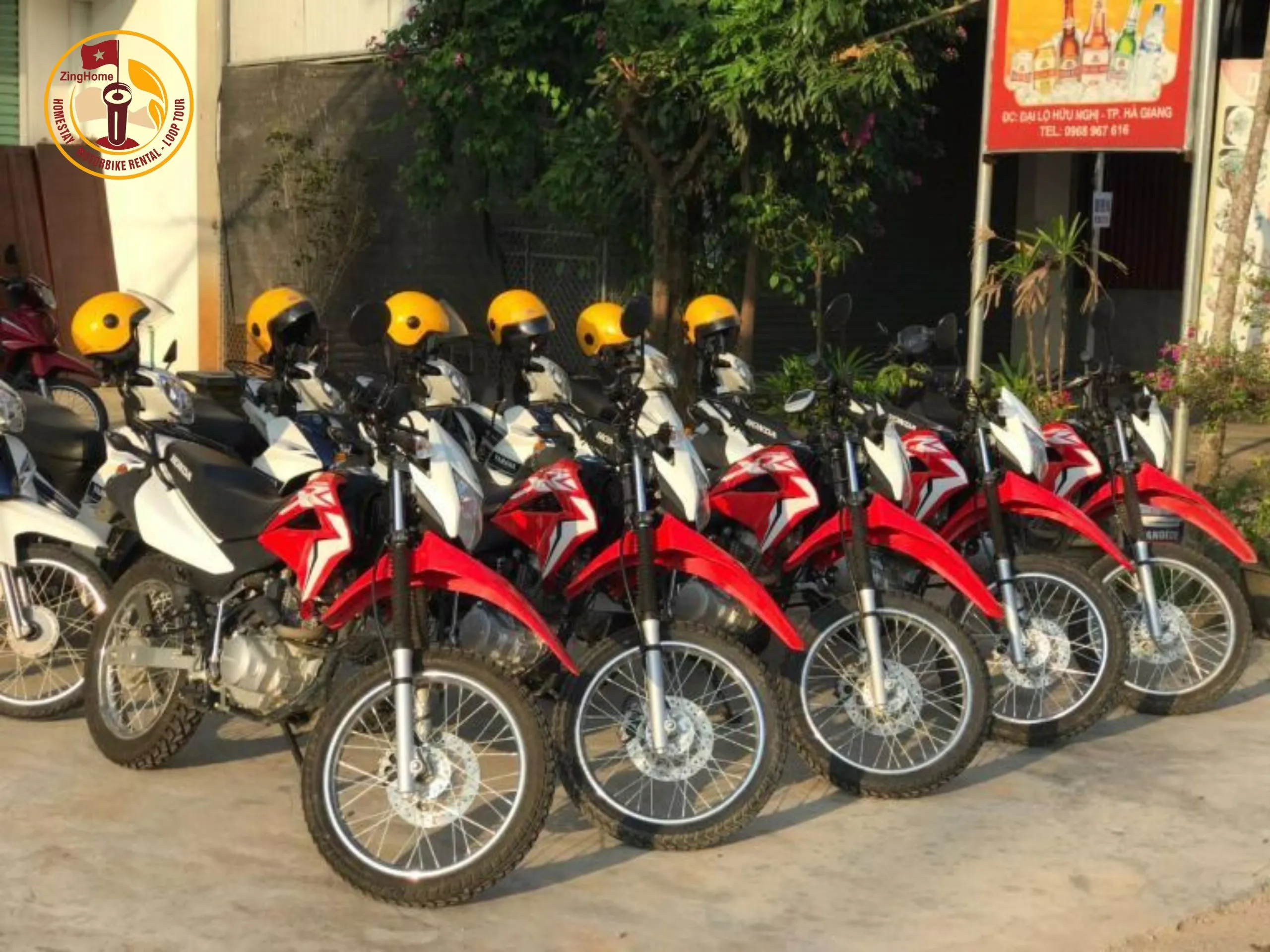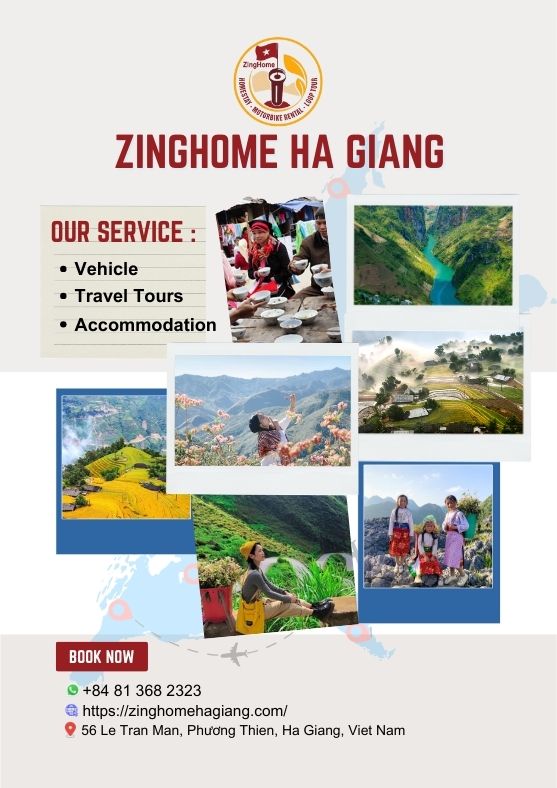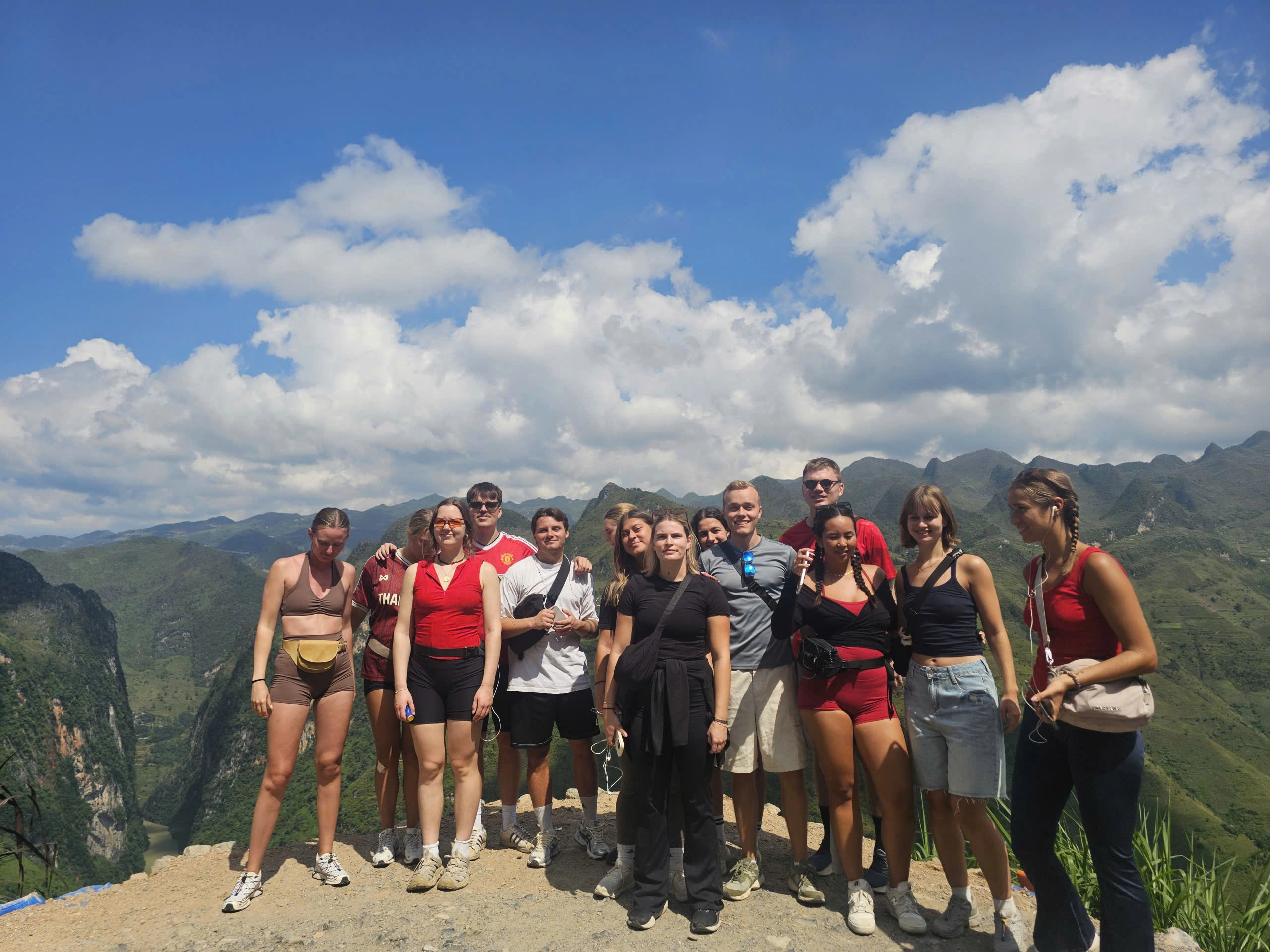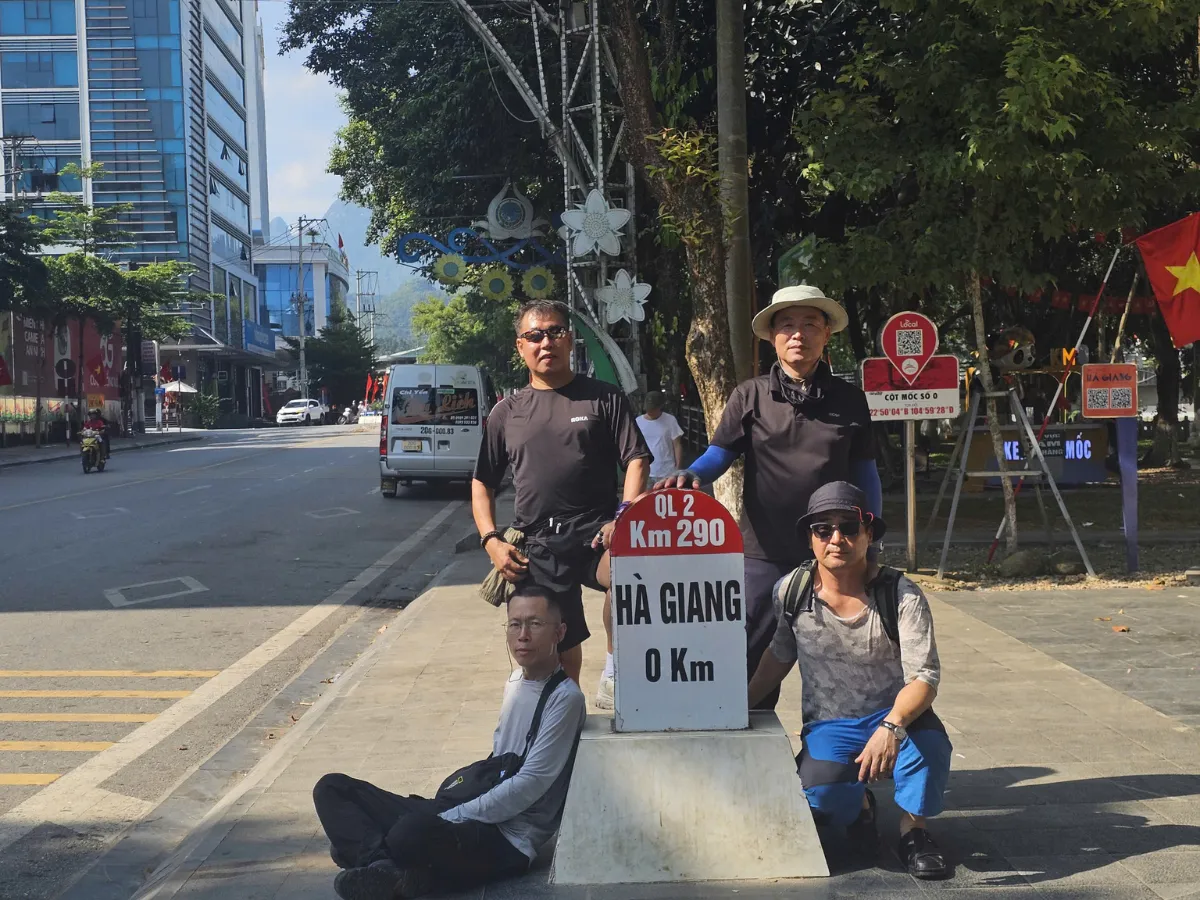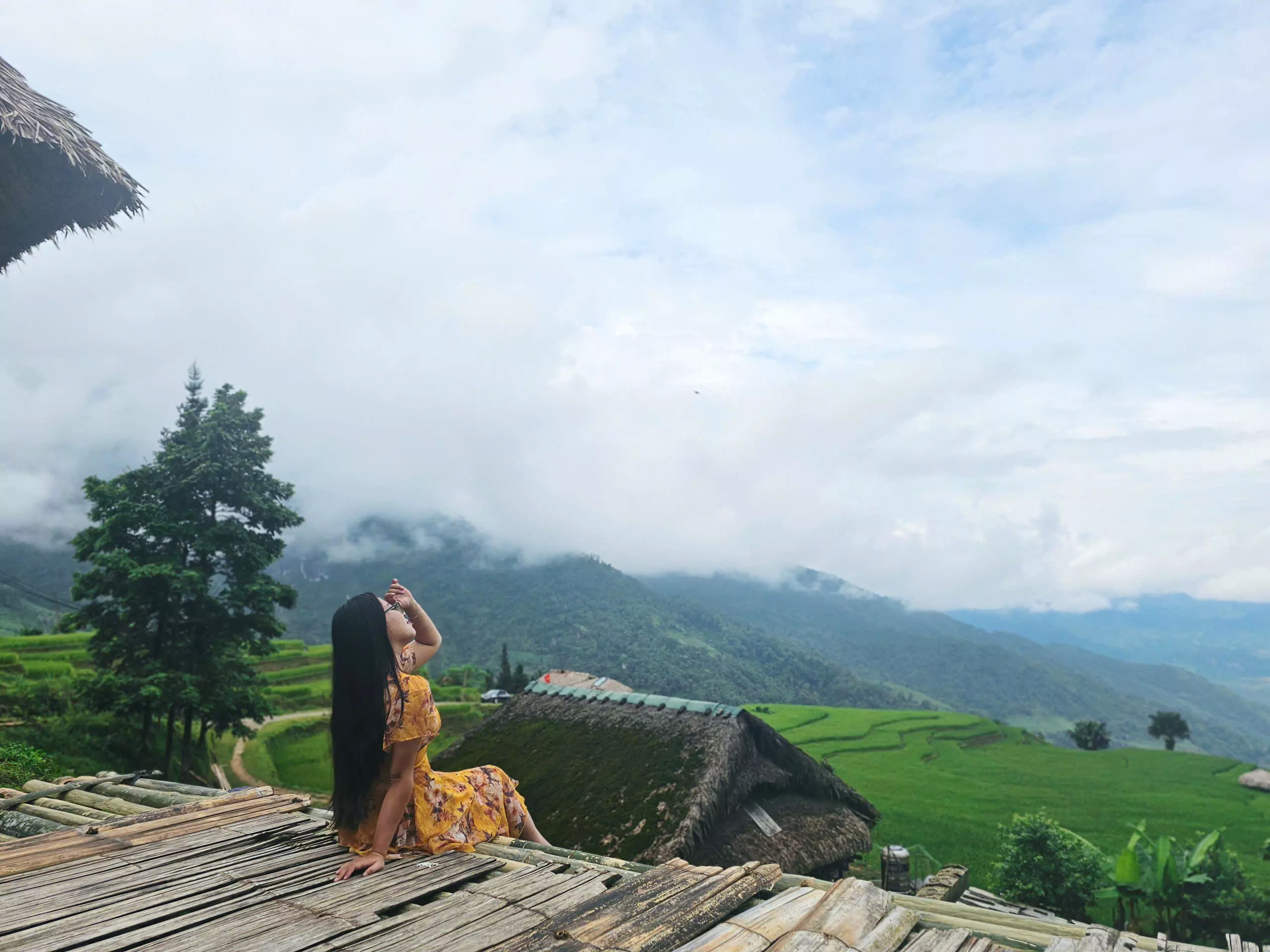Traveling from Da Nang to Ha Giang is an exhilarating journey that immerses you in Vietnam’s most spectacular landscapes and vibrant culture. As you traverse from the beautiful coastal city of Da Nang to the mountainous and remote region of Ha Giang, expect a mix of stunning views, rich ethnic diversity, and unique local cuisines that will captivate your senses.
The route is not just about reaching your destination; it’s about experiencing the transformations in scenery and ambiance that Vietnam offers, making it an unforgettable adventure for any traveler.
Traveling from Da Nang to Ha Giang
Traveling from Da Nang to Ha Giang is an iconic trip in Vietnam that promises travelers a kaleidoscope of experiences. The journey covers approximately 650 kilometers, showcasing the dramatic transformation from coastal landscapes to mountainous terrains.
As you begin your journey, you can hop on a plane to Hanoi, then progress to Ha Giang via bus or train, which not only saves time but also ensures you enjoy stunning aerial views of the landscapes below. Alternatively, for those who are more inclined to road trips, a long-distance bus directly from Da Nang offers a more immersive and adventurous experience. This bus ride may take upwards of 20 hours, allowing you to soak in the intricate details of the Vietnamese countryside as the landscape unfolds before you.
Regardless of your chosen method of transportation, it’s important to factor in the time required for transfers and any potential delays. Travelers can enjoy local food, beautiful views, and even make friends along the way. A scenic drive through the regions is known to produce fascinating encounters, especially if you stop at local markets and towns.
It’s important to consider the ideal travel dates as well; the best months to travel are from September to November when you can see the rice terraces in full golden glory, or from March to May when flowers bloom all across the region.
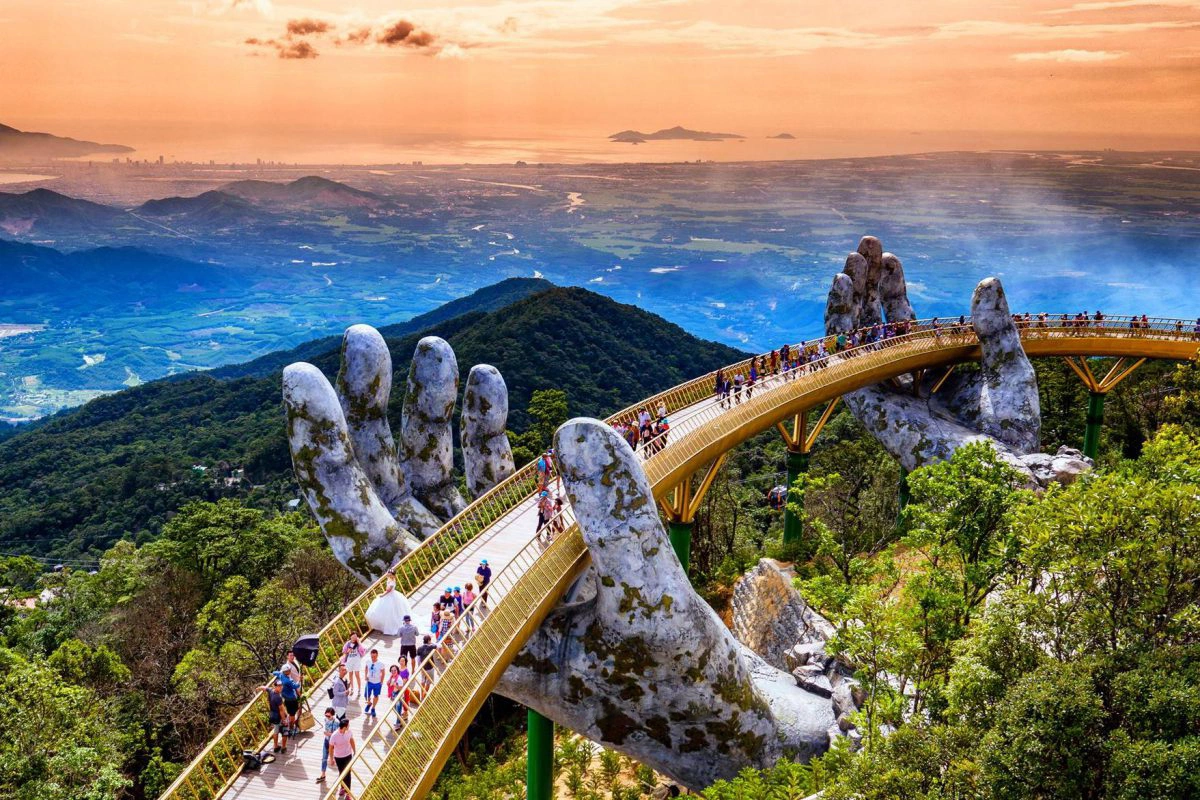
The Golden Bridge in Da Nang is one of Vietnam’s most iconic landmarks, gracefully curving through the misty hills of Ba Na Hills. Supported by two giant stone hands emerging from the mountains, the bridge offers breathtaking panoramic views of lush forests and distant cityscapes.
Transportation Options
After gauging the spectacular experiences awaiting you in Ha Giang, it’s time to explore the various transportation options for your journey from Da Nang — the starting point of your northern adventure.
The most popular and convenient way is to travel by plane and bus. You can take a short flight from Da Nang to Hanoi, which lasts about one hour, followed by a bus ride from Hanoi to Ha Giang that takes approximately 7–8 hours. Multiple bus operators offer both early morning and late-night departures, giving you flexibility in planning your trip. The total cost typically ranges from $30 to $75 for the flight and $10 to $15 for the bus fare.
Another option is the train and bus combination, ideal for travelers who enjoy scenic journeys. The train from Da Nang to Hanoi takes about 16–18 hours, allowing you to admire Vietnam’s picturesque countryside from the window. Once in Hanoi, you can catch a bus to Ha Giang, which adds another 7–8 hours to your trip. Expect to pay around $17 to $40 for the train ticket and $10 to $13 for the bus.
If you prefer a direct route, consider taking a long-distance bus from Da Nang to Ha Giang. Though less common, this option provides a continuous ride of about 20–24 hours. Prices generally range between $28 and $48, depending on the operator, with companies like Sapa Discovery Travel offering multiple departures throughout the day.
For those seeking comfort and flexibility, a private vehicle is an excellent choice. The drive takes approximately 13–15 hours, giving you the freedom to stop for scenic photos or local meals along the way. Costs vary depending on the type of car and service level, but this option ensures a smoother and more personalized experience from Da Nang to Ha Giang.
Flights from Da Nang to Hanoi
Flying from Da Nang to Hanoi is one of the most convenient ways to begin your Da Nang to Ha Giang adventure. The flight typically takes around 1 hour and 15 minutes, with several airlines operating daily, giving travelers plenty of flexibility to plan their schedules.
Major carriers such as VietJet Air, Vietnam Airlines, Bamboo Airways, and Jetstar Pacific offer frequent departures with competitive fares. Ticket prices vary depending on the booking time and travel season, generally ranging from 600,000 VND to 3,500,000 VND (approximately $26 to $150).
Choosing to fly offers several advantages. The most notable is speed—it’s the fastest and most efficient way to cover the long distance from Da Nang to Ha Giang, especially compared to train or bus travel. Moreover, the frequency of flights ensures travelers can easily find a time that suits their itinerary.
However, there are also a few downsides to consider. Cost is typically higher than land transportation, particularly if tickets aren’t booked early. Additionally, the airport check-in and transfer process can add extra time to your journey. Still, for most travelers heading from Da Nang to Ha Giang, flying to Hanoi first is the smartest and most time-saving way to start this breathtaking northern adventure.
Bus Travel from Hanoi to Ha Giang
Traveling by bus from Hanoi to Ha Giang is one of the most popular and budget-friendly options for those embarking on the Da Nang to Ha Giang journey. This route offers a perfect balance between comfort and scenic immersion, allowing travelers to witness the raw beauty of northern Vietnam up close. The ride typically takes around 6 to 8 hours, with modern and comfortable sleeper buses available for a smoother experience.
Several reputable operators, such as Bang Phan and Mat Troi, provide well-maintained buses equipped with reclining seats, blankets, and sometimes even onboard Wi-Fi. It’s highly recommended to book tickets in advance, especially during peak travel seasons, as buses tend to fill up quickly. Ticket prices are quite reasonable, ranging from $15 to $25, making it an excellent choice for budget-conscious travelers heading from Da Nang to Ha Giang via Hanoi.
The journey itself is a memorable part of the adventure. As you wind through the misty northern mountains, you’ll be treated to spectacular views of valleys, rivers, and terraced rice fields—a true preview of the beauty awaiting you in Ha Giang. For convenience, consider booking an evening departure between 18:00 and 21:30, so you can rest comfortably during the trip and arrive in Ha Giang refreshed and ready to explore the next morning.
Travel Itineraries
Having explored transportation options, it’s essential to consider how you can maximize your time when you arrive in Ha Giang. The following itineraries provide well-structured days to experience the region’s highlights effectively.
5-Day Itinerary: Da Nang to Ha Giang Loop Adventure
Day 1: Da Nang to Hanoi
Begin your Da Nang to Ha Giang journey early in the morning. You can take a flight from Da Nang to Hanoi (around 1 hour and 15 minutes) or choose an overnight train or bus if you prefer land travel. Spend the afternoon exploring Hanoi’s Old Quarter, Hoan Kiem Lake, and sampling some of the city’s renowned street food like bun cha and egg coffee.
Night 1: Hanoi to Ha Giang- In the evening, take a sleeper bus from Hanoi to Ha Giang. The journey usually lasts 6–8 hours, so you’ll arrive early the next morning, rested and ready for your mountain adventure.
Day 2: Start the Ha Giang Loop – Ha Giang to Dong Van
Arrive in Ha Giang early morning and grab breakfast before renting a motorbike or joining a guided tour to begin the Ha Giang Loop. Ride through Quan Ba Heaven Gate, Yen Minh, and reach Dong Van town by late afternoon. Along the way, enjoy incredible views of terraced rice fields and limestone peaks. Spend the night in Dong Van, where you can explore the old quarter and savor local specialties.
Day 3: Dong Van – Ma Pi Leng Pass – Meo Vac
Continue your journey through the most spectacular part of the Ha Giang Loop. Ride across the legendary Ma Pi Leng Pass, offering panoramic views of the Nho Que River below. Stop at scenic viewpoints to capture the stunning landscape before arriving in Meo Vac. In the afternoon, explore nearby ethnic minority villages and relax at your homestay in Meo Vac.
Day 4: Meo Vac – Du Gia Village
Depart from Meo Vac and head toward Du Gia, a peaceful mountain village surrounded by Du Gia waterfalls and rice terraces. The road offers breathtaking scenery and a more authentic glimpse into rural Ha Giang life. Spend the night in a local homestay in Du Gia, enjoying home-cooked meals and traditional hospitality.
Day 5: Du Gia – Ha Giang – Return to Hanoi
After breakfast, ride back to Ha Giang city, completing your unforgettable Ha Giang Loop adventure. Return your motorbike, have lunch, and rest before boarding the evening sleeper bus back to Hanoi (departure between 18:00–21:30). You’ll arrive in Hanoi early the next morning, concluding your amazing Da Nang to Ha Giang trip filled with adventure, scenic roads, and cultural discovery.

The Nho Que River gracefully winds through the heart of Ha Giang’s mountains, painting a stunning picture of emerald-green waters cutting between towering limestone cliffs.
Key Attractions Along the Route
Traveling from Da Nang to Ha Giang offers an incredible journey filled with captivating destinations and diverse landscapes that will delight every traveler. Along the way, you’ll encounter some of Vietnam’s most remarkable natural and cultural attractions.
One of the first highlights is Phong Nha–Ke Bang National Park, a UNESCO World Heritage Site renowned for its breathtaking cave systems and underground rivers. It’s a paradise for adventure seekers who enjoy hiking, spelunking, and immersing themselves in untouched nature.
Next, make a stop in Hue, the former imperial capital of Vietnam. Rich in history and culture, Hue is home to the majestic Imperial City, royal tombs, and ancient pagodas that tell stories of Vietnam’s glorious past.
Continuing north, Ninh Binh awaits with its postcard-perfect scenery—often called Halong Bay on land. Here, vast rice paddies stretch between towering limestone cliffs, and tranquil boat tours through Tam Coc or Trang An offer a peaceful escape into nature’s splendor.
For a more authentic countryside experience, visit Mai Chau, a charming valley surrounded by emerald rice terraces. Staying in local homestays here allows you to experience traditional village life and the warm hospitality of the Thai ethnic community.
As you near the northern highlands, the journey from Da Nang to Ha Giang reaches its most dramatic point. The Dong Van Karst Plateau, part of a UNESCO Global Geopark, showcases breathtaking limestone formations and vibrant ethnic cultures. Finally, don’t miss the legendary Ma Pi Leng Pass, one of Vietnam’s most scenic mountain roads. This awe-inspiring stretch along the Ha Giang Loop offers panoramic views of the Nho Que River winding between towering cliffs—a sight that truly defines the wild beauty of northern Vietnam.
Ha Giang Loop Highlights
Highlighting the must-see attractions along the renowned Ha Giang Loop is essential for planning the perfect Da Nang to Ha Giang adventure. This northern route is packed with awe-inspiring landscapes, cultural treasures, and unforgettable viewpoints that showcase the very best of Vietnam’s highlands.
Begin your journey at Quan Ba Heaven Gate, the official gateway to the spectacular Dong Van Karst Plateau. This viewpoint, often shrouded in early morning mist, offers panoramic vistas of the valleys below and is a favorite spot for photographers seeking to capture Ha Giang’s ethereal beauty.
Just nearby, the Twin Mountains (Fairy Hills) stand as one of Ha Giang’s most iconic natural landmarks. Surrounded by local legends, these twin limestone peaks symbolize harmony and balance, making them a must-visit stop for those interested in both folklore and photography.
Continue north to the Lung Cu Flag Tower, proudly marking Vietnam’s northernmost point. After climbing its 839 steps, travelers are rewarded with breathtaking views stretching across valleys and even into neighboring China a truly patriotic and scenic experience.
No Da Nang to Ha Giang itinerary would be complete without the world-famous Ma Pi Leng Pass, often hailed as one of the most beautiful mountain roads in all of Vietnam. The twisting route hugs towering cliffs high above the Nho Que River, offering some of the most mesmerizing views in Southeast Asia.
At the base of Ma Pi Leng lies the majestic Tu San Canyon, recognized as the deepest canyon in Southeast Asia. Taking a boat trip along the Nho Que River here provides an unforgettable perspective of the towering karst formations and emerald waters that define Ha Giang’s rugged charm.
Exploring the Dong Van Karst Plateau, a designated UNESCO Global Geopark, immerses travelers in a landscape of striking rock formations and rich cultural diversity, where ethnic minority communities maintain vibrant traditions. Finally, end your journey in Meo Vac, a lively mountain town best known for its Sunday market, where local tribes gather to trade goods, socialize, and celebrate their heritage—offering visitors a colorful glimpse into authentic highland life.
Accommodation Options
When it comes to choosing where to stay along your journey from Da Nang to Ha Giang, various accommodation options cater to different budgets and preferences.
Best Hotels in Ha Giang
When planning your Da Nang to Ha Giang journey, choosing the right accommodation can greatly enhance your experience. Ha Giang offers a wide range of stays, from luxurious hotels to cozy hostels and budget-friendly homestays all providing comfort after long days exploring the majestic northern landscapes.
For travelers seeking modern comfort, ZingHome Ha Giang is an excellent choice. Conveniently located in the city center, it provides clean, stylish rooms and warm local hospitality. Guests can easily arrange Ha Giang motorbike rental directly from the property, making it an ideal base for starting the Ha Giang Loop.
Another top-rated option is Four Points by Sheraton Ha Giang, boasting a 9.3 rating. This luxurious stay offers premium amenities, a relaxing bar, and rejuvenating massage services perfect for unwinding after a day of mountain exploration. Prices start at approximately £42.93 per night.
For a more social and budget-friendly experience, Ha Giang City Hostel (rated 9.2) features shared kitchens, a scenic terrace, and friendly staff always ready to assist. Rates begin around £7.86 per night, making it ideal for backpackers traveling from Da Nang to Ha Giang.
Ha Giang Motorbike Rental (rating 9.7), guests enjoy spacious rooms and convenient on-site motorbike rentals. This makes it particularly suitable for those eager to embark on the Ha Giang Loop independently. Rooms are available from 13.31 USD or Free stay while waiting for dorm check-in
Travelers looking for family-friendly comfort can consider Yen Bien Luxury Hotel (rating 8.8), which features a swimming pool, modern facilities, and spacious family rooms starting at £31.01 per night.
For nature enthusiasts, Ha Giang Ecolodge (rating 9.4) provides an eco-friendly retreat surrounded by lush landscapes. Guests can enjoy panoramic mountain views, comfortable accommodations, and a tranquil atmosphere. Prices vary based on room type and season.
Budget travelers will also find plenty of welcoming hostels and homestays, with rates starting from just $10 per night. Great options include Yolo Ha Giang Adventures and Ma Pi Adventures, both offering authentic local experiences and easy access to Ha Giang motorbike rental services — the perfect way to explore this breathtaking region at your own pace.

The Ha Giang Loop is one of Vietnam’s most spectacular road journeys, stretching over 350 kilometers through dramatic limestone mountains, winding passes, and remote ethnic villages.
Activities in Ha Giang
Exploring Ha Giang provides an immersive adventure brimming with activities, from cultural experiences to outdoor adventures.
Motorbiking Experiences
The Ha Giang Loop is one of Vietnam’s most famous travel routes a 350-kilometer adventure through majestic mountains, rice terraces, and remote ethnic villages. For those traveling from Da Nang to Ha Giang, completing this loop is the highlight of the journey. It typically takes four to five days, giving travelers enough time to enjoy scenic stops, cultural interactions, and a true taste of northern Vietnam’s raw beauty.
Along the Ha Giang Loop, visitors are treated to some of the most breathtaking views in the country. Vast terraced rice fields, dramatic limestone peaks, and peaceful villages inhabited by ethnic minorities such as the Hmong make the journey an unforgettable experience. Among the top attractions, the legendary Ma Pi Leng Pass stands out a winding mountain road overlooking the turquoise Nho Que River, offering spectacular photo opportunities and heart-stopping views.
There’s no shortage of ways to experience the loop. Many companies and homestays including ZingHome Ha Giang provide Ha Giang motorbike rental and guided tours that include everything from well-maintained bikes to comfortable accommodation. Travelers can also engage directly with local communities, especially during vibrant market days, where ethnic groups gather to trade goods, share meals, and celebrate their culture.
When riding the Ha Giang Loop, safety should always come first. The roads can be narrow and winding, so a valid international driver’s license is required for those driving on their own. For less experienced riders, joining a guided tour or hiring a local driver is highly recommended. Fortunately, various Ha Giang motorbike rental services ensure that bikes are properly checked and equipped for the rugged terrain allowing every traveler to embark on a safe and memorable Da Nang to Ha Giang adventure.
Trekking Routes in Ha Giang
Trekking in Ha Giang is an unforgettable adventure that immerses travelers in breathtaking mountain scenery, authentic ethnic cultures, and peaceful trails far less crowded than those in destinations like Sapa. For anyone journeying from Da Nang to Ha Giang, adding a trekking experience to your itinerary is the perfect way to connect deeply with the land and its people.
One of the most iconic routes is the Ma Pi Leng Pass, offering dramatic views over the Ma Pi Leng Gorge and the winding Nho Que River below. Known for its towering cliffs and panoramic vistas, this trek is ideal for adventurers who want to witness Ha Giang’s wild beauty up close.
Another remarkable route is the Jubo Trail to Meo Vac, stretching approximately 14.8 kilometers through rugged terrain. This challenging path takes trekkers across remote highlands and traditional villages, providing glimpses into the daily life and unique culture of local ethnic groups.
For those seeking a shorter yet rewarding route, the Sky Path is a great choice. This 3.1-kilometer moderate hike offers stunning viewpoints perfect for photography while still providing a satisfying challenge amid the serene northern landscape.
Most Ha Giang trekking tours last from two to five days, with options for both guided and independent exploration. Hiring a local guide is highly recommended — not only to navigate the trails safely but also to gain deeper insight into the traditions, stories, and lifestyles that define this region. With the right preparation and a sense of adventure, trekking in Ha Giang adds a truly enriching dimension to your Da Nang to Ha Giang journey.
Travel Tips
When traveling from Da Nang to Ha Giang, a few essential tips make the journey smoother and more enjoyable.
Weather Considerations
Understanding seasonal weather variations is essential when planning your Da Nang to Ha Giang journey, as the region’s mountainous terrain and diverse climate can greatly influence your travel experience.
The dry season (October to April) is generally the most favorable time to visit. During these months, temperatures are mild, humidity is lower, and visibility is excellent especially from March to May, which is perfect for outdoor adventures like trekking or completing the Ha Giang Loop by motorbike. In contrast, the rainy season (May to September) brings heavier rainfall, which can sometimes cause landslides and make travel through remote areas more difficult. Roads leading into Ha Giang may become muddy and slippery, requiring extra caution for riders using Ha Giang motorbike rental services.
Here are some practical travel tips to help you prepare. Always check the weather forecast before setting out apps like Windy.com provide accurate, real-time updates. If you’re traveling during the rainy months, be prepared for challenging road conditions; ensure your motorbike is in good shape and that you’re confident handling it on wet, winding terrain. When packing, bring waterproof gear, sturdy footwear, and warm clothing, as temperatures can drop significantly at night in the mountains.
From local insights, it’s best to avoid travel during peak rainy periods, particularly in July and August, when downpours are most intense and landslides are more frequent. Always inform someone of your travel plans before heading out, especially if you’re exploring the Ha Giang Loop independently. With the right preparation, your Da Nang to Ha Giang adventure will be both safe and unforgettable, no matter the season.
Cultural Insights
Cultural Highlights Along the Journey from Da Nang to Ha Giang: Cultural factors significantly enhance the journey from Da Nang to Ha Giang, offering travelers a deeper understanding of Vietnam’s diversity. Beyond its scenic landscapes, Ha Giang is a living museum of ethnic traditions and authentic mountain life.
Diverse Ethnic Communities: Ha Giang is home to over 22 ethnic groups, including the Hmong, Dao, Tay, and Lo Lo. Each group brings unique customs, clothing styles, and festivals that together form a vibrant cultural mosaic. Engaging with these communities allows travelers to experience the warmth and hospitality that define Ha Giang.
Scenic Landscapes and Agriculture:The province’s breathtaking scenery blends cultural and natural beauty. Terraced rice fields, stretching across steep hillsides, symbolize generations of harmonious coexistence with nature. Ha Giang is also known for cultivating buckwheat and corn, which play vital roles in both local diets and cultural celebrations.
Local Markets: Traditional markets like the Dong Van Market and Meo Vac Sunday Market serve as lively cultural centers. Here, visitors can find colorful ethnic textiles, handcrafted silver jewelry, and traditional dishes. These markets are also ideal stops for riders exploring the region with Ha Giang motorbike rental services, offering authentic encounters along the route.
Festivals: The Buckwheat Flower Festival in October and November paints Ha Giang’s valleys in shades of pink and purple. These festivals showcase folk music, traditional dances, and regional cuisine perfect for those staying at places like ZingHome Ha Giang who want to immerse themselves in local life.
Respect for Cultural Customs: When visiting ethnic villages, it’s essential to respect traditions dress modestly, avoid entering homes without invitation, and always ask permission before taking photos. Such mindfulness enriches your journey and supports responsible tourism in one of Vietnam’s most culturally diverse regions.
Local Cuisine and Delicacies: Cuisine is an essential aspect of traveling, and both Da Nang and Ha Giang present diverse culinary landscapes.
Da Nang Cuisine
Culinary Highlights in Da Nang Before Heading to Ha Giang
Before beginning your journey from Da Nang to Ha Giang, take time to explore Da Nang’s vibrant food scene a flavorful introduction to Vietnam’s rich culinary diversity.
Mi Quang: No visit to Da Nang is complete without tasting Mi Quang, the city’s signature noodle dish. It’s a delicious mix of turmeric noodles, shrimp, pork, and fresh herbs, often topped with roasted peanuts and crispy rice crackers. This hearty, colorful meal perfectly captures the soul of Central Vietnam cuisine.
Banh Xeo: Another must-try is Banh Xeo, crispy Vietnamese pancakes made with rice flour and turmeric, then filled with shrimp, pork, and bean sprouts. Locals wrap the pancakes in fresh greens and dip them into a tangy fish sauce a perfect street food experience before heading north.
Fresh Seafood at Con Market: Da Nang’s coastal charm shines through its abundance of fresh seafood. At Con Market, travelers can savor local favorites like tamarind squid, grilled scallops, and Banh Beo small steamed rice cakes topped with shrimp and scallions. These dishes offer a perfect prelude to the cultural and culinary adventures awaiting in Ha Giang.
For those planning a longer journey, you can continue north after Da Nang, using Rent motorbike Ha Giang services for an unforgettable ride through Vietnam’s majestic highlands once you reach the northern province.
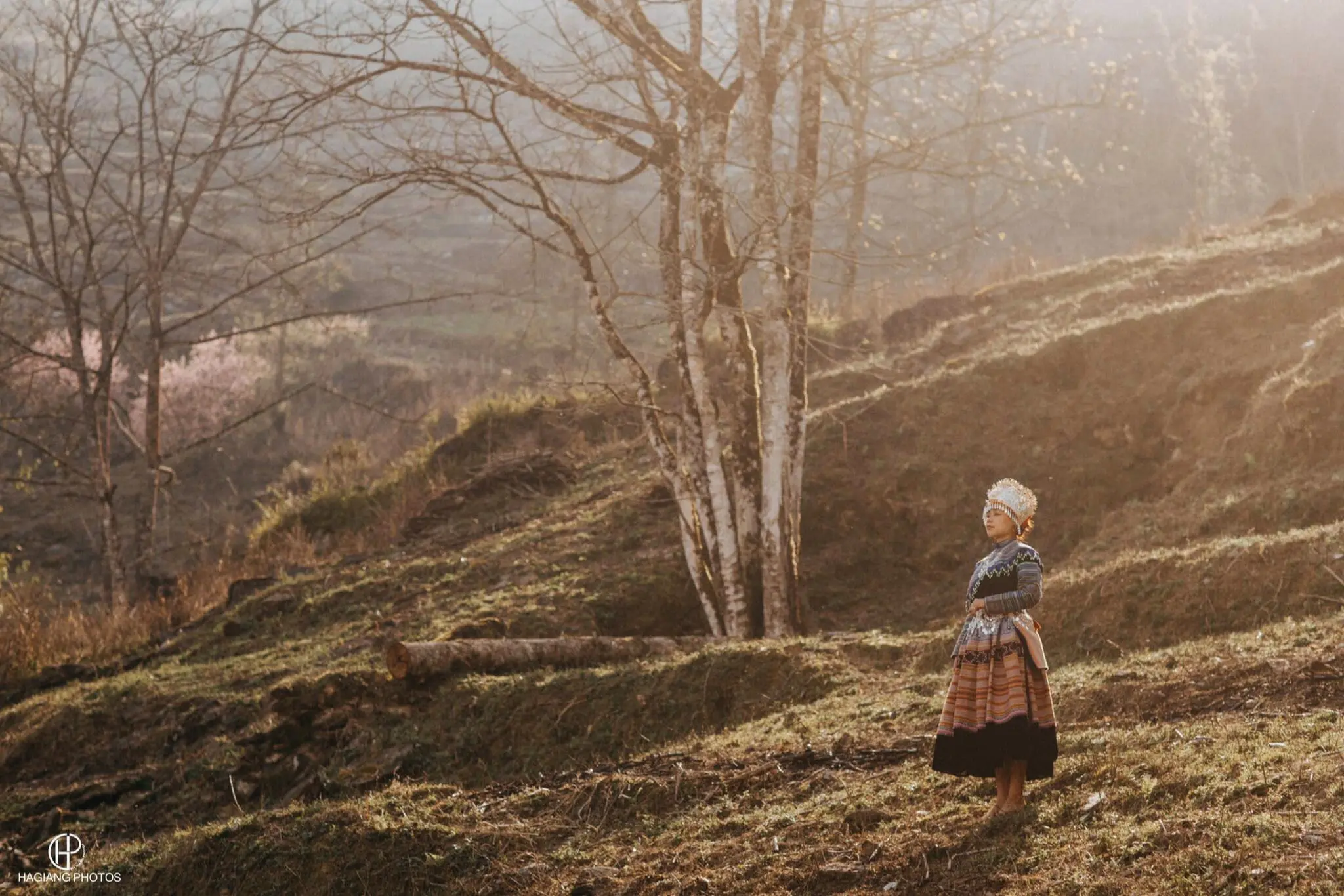
Scenic mountain road from Da Nang to Ha Giang in November with misty valleys and golden rice terraces.
Ha Giang Cuisine
Culinary Experiences in Ha Giang A Taste of Ethnic Diversity
As you journey from Da Nang to Ha Giang, the culinary landscape transforms dramatically, reflecting the region’s rich ethnic mosaic and mountain traditions. In Ha Giang, every dish carries a story one shaped by its people, history, and land.
Thang Co: A traditional Hmong delicacy, Thang Co is a hearty soup made from horse meat, slow-cooked with herbs and spices. Typically enjoyed during local festivals and gatherings, this dish symbolizes community and celebration. Visitors can find it in mountain markets around Dong Van or Meo Vac, where it’s served steaming hot in large communal pots.
Five-Color Sticky Rice (Xôi Ngũ Sắc) : This visually stunning dish features sticky rice dyed with natural plant extracts into five distinct colors red, yellow, green, purple, and white each representing the harmony of nature. It’s a festive food, often shared during New Year and family ceremonies among ethnic groups like the Tay and Nung.
Banh Tam Giac Mach (Buckwheat Cake): Made from the local buckwheat flowers that blanket the hillsides in autumn, these soft cakes are a Ha Giang specialty. Slightly sweet and nutty, they embody the province’s agricultural identity and creativity.
For travelers exploring the northern highlands, staying at ZingHome Ha Giang offers both comfort and a local touch, while nearby Ha Giang motorbike rental options make it easy to reach authentic food markets and remote villages where the best traditional dishes are often found.
Traveling from Da Nang to Ha Giang is more than just a physical journey; it’s a cultural and emotional adventure through some of Vietnam’s most breathtaking landscapes. Each element, from transport options to itineraries and local experiences, contributes to an immersive exploration into the heart of northern Vietnam.
Whether you’re gazing at the golden rice terraces, hanging out with local ethnic minorities, or indulging in local cuisine, there is an abundance of stories waiting to be told. Prepare well for your adventure, absorbing every moment, culture, and flavor, and you’ll return with memories that last a lifetime. The beauty of this journey is everlasting and only intensifies with every visit.







